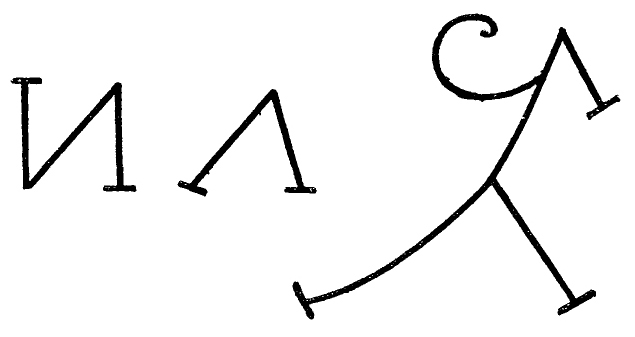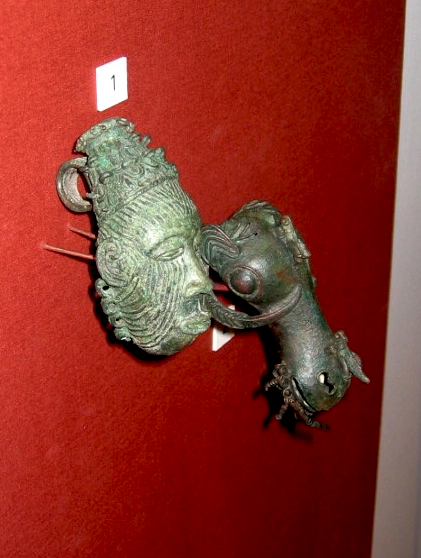|
Nsibidi
Nsibidi (also known as nsibiri, nchibiddi or nchibiddy) is a system of symbols or proto-writing developed in what is now the far South of Nigeria. They are classified as pictograms, though there have been suggestions that some are logograms or syllabograms. Use of the symbol system was first described in 1904. Excavation of terracotta vessels, headrests, and anthropomorphic figurines from the Calabar region of southeast Nigeria, dated to roughly the 5th to 15th centuries, revealed "an iconography readily comparable" to ''nsibidi''. There are several hundred nsibidi symbols. They were once taught in a school to children. Many of the signs deal with love affairs; those that deal with warfare and the sacred are kept secret. Nsibidi is used on wall designs, calabashes, metals (such as bronze), leaves, swords, and tattoos. It is primarily used by the Ekpe leopard society (also known as Ngbe or Egbo), a secret society that is found across Cross River State among the Ekoi, Efik, I ... [...More Info...] [...Related Items...] OR: [Wikipedia] [Google] [Baidu] |
Igbo Language
Igbo ( , ; Igbo: ''Ásụ̀sụ́ Ìgbò'' ) is the principal native language cluster of the Igbo people, a meta-ethnicity from Southeastern Nigeria. The number of Igboid languages depends on how one classifies a language versus a dialect, so there could be around 15 different Igboid languages. The core Igbo cluster or Igbo proper is generally thought to be one language but there is limited mutual intelligibility between the different groupings (north, west, south and east). A standard literary language termed 'Igbo izugbe' (meaning "general igbo") was generically developed and later adopted around 1972, with its core foundation based on the Owerri (Isuama), Anambra (Awka) and Umuahia (Ohuhu) dialects, omitting the nasalization and aspiration of those varieties. However, nobody speaks "general Igbo" natively and it isn't accepted by all Igbo groups. The largest variety of the core Igbo cluster is Ngwa. History The first book to publish Igbo terms was ''History of the Missio ... [...More Info...] [...Related Items...] OR: [Wikipedia] [Google] [Baidu] |
Igbo People
The Igbo people ( , ; also spelled Ibo" and formerly also ''Iboe'', ''Ebo'', ''Eboe'', * * * ''Eboans'', ''Heebo''; natively ) are an ethnic group in Nigeria. They are primarily found in Abia, Anambra, Ebonyi, Enugu, and Imo States. A sizable Igbo population is also found in Delta and Rivers States. Large ethnic Igbo populations are found in Cameroon, Gabon, and Equatorial Guinea, as well as outside Africa. There has been much speculation about the origins of the Igbo people, which are largely unknown. Geographically, the Igbo homeland is divided into two unequal sections by the Niger River—an eastern (which is the larger of the two) and a western section. The Igbo people are one of the largest ethnic groups in Africa. The Igbo language is part of the Niger-Congo language family. Its regional dialects are somewhat mutually intelligible amidst the larger "Igboid" cluster. The Igbo homeland straddles the lower Niger River, east and south of the Edoid and Idomoid gr ... [...More Info...] [...Related Items...] OR: [Wikipedia] [Google] [Baidu] |
Leopard Society
The Leopard Society (not to be confused with Ekpe), was a secret society that originated in Sierra Leone. Beatty, p.3 It was believed that members of the society could transform into leopards through the use of witchcraft. The earliest reference to the society in historical literature can be found in George Banbury's "Sierra Leone: or the white man's grave" (1888). The society brought fear to many parts of the world. History The Leopard Society was a West African secret society active in the early to mid-20th century. They were originally centred in Sierra Leone but spread to other countries such as Liberia, Côte d'Ivoire and Nigeria. Among the Efik of Calabar, they were known as Mforoekpe and were dreaded. Members would dress in leopard skins, waylaying travelers with sharp claw-like weapons in the form of leopards' claws and teeth. The victims' flesh would be cut from their bodies and distributed to members of the secret society. According to their beliefs, the ritual canniba ... [...More Info...] [...Related Items...] OR: [Wikipedia] [Google] [Baidu] |
Proto-writing
Proto-writing consists of visible marks communicating limited information. Such systems emerged from earlier traditions of symbol systems in the early Neolithic, as early as the 7th millennium BC in Eastern Europe and China. They used ideographic or early mnemonic symbols or both to represent a limited number of concepts, in contrast to true writing systems, which record the language of the writer. Neolithic Neolithic China In 2003, tortoise shells were found in 24 Neolithic graves excavated at Jiahu, Henan province, northern China, with radiocarbon dates from the 7th millennium BC. According to some archaeologists, the symbols carved on the shells had similarities to the late 2nd millennium BC oracle bone script.. Others have dismissed this claim as insufficiently substantiated, claiming that simple geometric designs such as those found on the Jiahu shells cannot be linked to early writing. Neolithic Europe The Dispilio tablet is a wooden tablet bearing inscribed marki ... [...More Info...] [...Related Items...] OR: [Wikipedia] [Google] [Baidu] |
Ekoi People
Ekoi people, also known as Ejagham, are an ethnic group in the extreme south of Nigeria and extending eastward into the southwest region of Cameroon. They speak the Ejagham language. Other Ekoi languages are spoken by related groups, including the Etung, some groups in Ikom (such as Ofutop, Akparabong and Nde), some groups in Ogoja (Ishibori and Bansarra), Ufia and Yakö. The Ekoi have lived closely with the nearby Efik, Annang, Ibibio and Igbo people of southeastern Nigeria. The Ekoi are best known for their Ekpe headdresses and the Nsibidi text. They traditionally use Nsibidi ideograms, and are the group that originally created them. Geography The Ekoi in Nigeria are found in Cross River State. The Ekoid languages are spoken around this area, although English (the national language) is also spoken. The Ekoi in Cameroon are found in the southwestern region of the country. History The Ekoi originated from the Lake Ejagham area. The Ekoi believe that the heirs of the first ... [...More Info...] [...Related Items...] OR: [Wikipedia] [Google] [Baidu] |
Robert Farris Thompson
Robert Farris Thompson (December 30, 1932 – November 29, 2021) was an American art historian and writer who specialized in Africa and the Afro-Atlantic world. He was a member of the faculty at Yale University from 1965 to his retirement more than fifty years later and served as the Colonel John Trumbull Professor of the History of Art. Thompson coined the term "black Atlantic" in his 1983 book ''Flash of the Spirit: African and Afro-American Art and Philosophy'' – the expanded subject of Paul Gilroy's book ''The Black Atlantic''. He lived in the Yoruba region of southwest Nigeria while he conducted his research of Yoruba arts history. He was affiliated with the University of Ibadan and frequented Yoruba village communities. Thompson studied the African arts of the diaspora in the United States, Mexico, Argentina, Cuba, Haiti, Puerto Rico, and several Caribbean islands. Career at Yale In 1955, Thompson received his B.A. from Yale University. After receiving his bachelor's d ... [...More Info...] [...Related Items...] OR: [Wikipedia] [Google] [Baidu] |
Veve
A ''veve'' (also spelled ''vèvè'' or ''vevè'') is a religious symbol commonly used in different branches of Vodun throughout the African diaspora, such as Haitian Vodou and Louisiana Voodoo. The ''veve'' acts as a "beacon" for the ''loa'', and will serve as a ''loa''s representation during rituals. ''Veves'' should not be confused with the ''patipembas'' used in Palo, nor the ''pontos riscados'' used in Umbanda and Quimbanda, as these are separate African religions. History Possible origins include the cosmogram of the Kongo people, or originated as the Nsibidi system of writing for the Igboid and Ekoid languages from West and Central Africa. Function According to Milo Rigaud, "The ''veves'' represent figures of the astral forces... In the course of Vodou ceremonies, the reproduction of the astral forces represented by the veves obliges the loas... to descend to earth." Every ''loa'' has his or her own unique ''veve'', although regional differences have led to different ' ... [...More Info...] [...Related Items...] OR: [Wikipedia] [Google] [Baidu] |
Atlantic Slave Trade
The Atlantic slave trade, transatlantic slave trade, or Euro-American slave trade involved the transportation by slave traders of enslaved African people, mainly to the Americas. The slave trade regularly used the triangular trade route and its Middle Passage, and existed from the 16th to the 19th centuries. The vast majority of those who were transported in the transatlantic slave trade were people from Central and West Africa that had been sold by other West Africans to Western European slave traders,Thornton, p. 112. while others had been captured directly by the slave traders in coastal raids; Europeans gathered and imprisoned the enslaved at forts on the African coast and then brought them to the Americas. Except for the Portuguese, European slave traders generally did not participate in the raids because life expectancy for Europeans in sub-Saharan Africa was less than one year during the period of the slave trade (which was prior to the widespread availability of quini ... [...More Info...] [...Related Items...] OR: [Wikipedia] [Google] [Baidu] |
Haiti
Haiti (; ht, Ayiti ; French: ), officially the Republic of Haiti (); ) and formerly known as Hayti, is a country located on the island of Hispaniola in the Greater Antilles archipelago of the Caribbean Sea, east of Cuba and Jamaica, and south of The Bahamas and the Turks and Caicos Islands. It occupies the western three-eighths of the island which it shares with the Dominican Republic. To its south-west lies the small Navassa Island, which is claimed by Haiti but is disputed as a United States territory under federal administration."Haiti" ''Encyclopædia Britannica''. Haiti is in size, the third largest country in the Caribbean by area, and has an estimated population of 11.4 million, making it the most populous country in the Caribb ... [...More Info...] [...Related Items...] OR: [Wikipedia] [Google] [Baidu] |
Cuba
Cuba ( , ), officially the Republic of Cuba ( es, República de Cuba, links=no ), is an island country comprising the island of Cuba, as well as Isla de la Juventud and several minor archipelagos. Cuba is located where the northern Caribbean Sea, Gulf of Mexico, and Atlantic Ocean meet. Cuba is located east of the Yucatán Peninsula (Mexico), south of both the American state of Florida and the Bahamas, west of Hispaniola ( Haiti/Dominican Republic), and north of both Jamaica and the Cayman Islands. Havana is the largest city and capital; other major cities include Santiago de Cuba and Camagüey. The official area of the Republic of Cuba is (without the territorial waters) but a total of 350,730 km² (135,418 sq mi) including the exclusive economic zone. Cuba is the second-most populous country in the Caribbean after Haiti, with over 11 million inhabitants. The territory that is now Cuba was inhabited by the Ciboney people from the 4th millennium BC with the Gua ... [...More Info...] [...Related Items...] OR: [Wikipedia] [Google] [Baidu] |



.jpg)
.jpg)